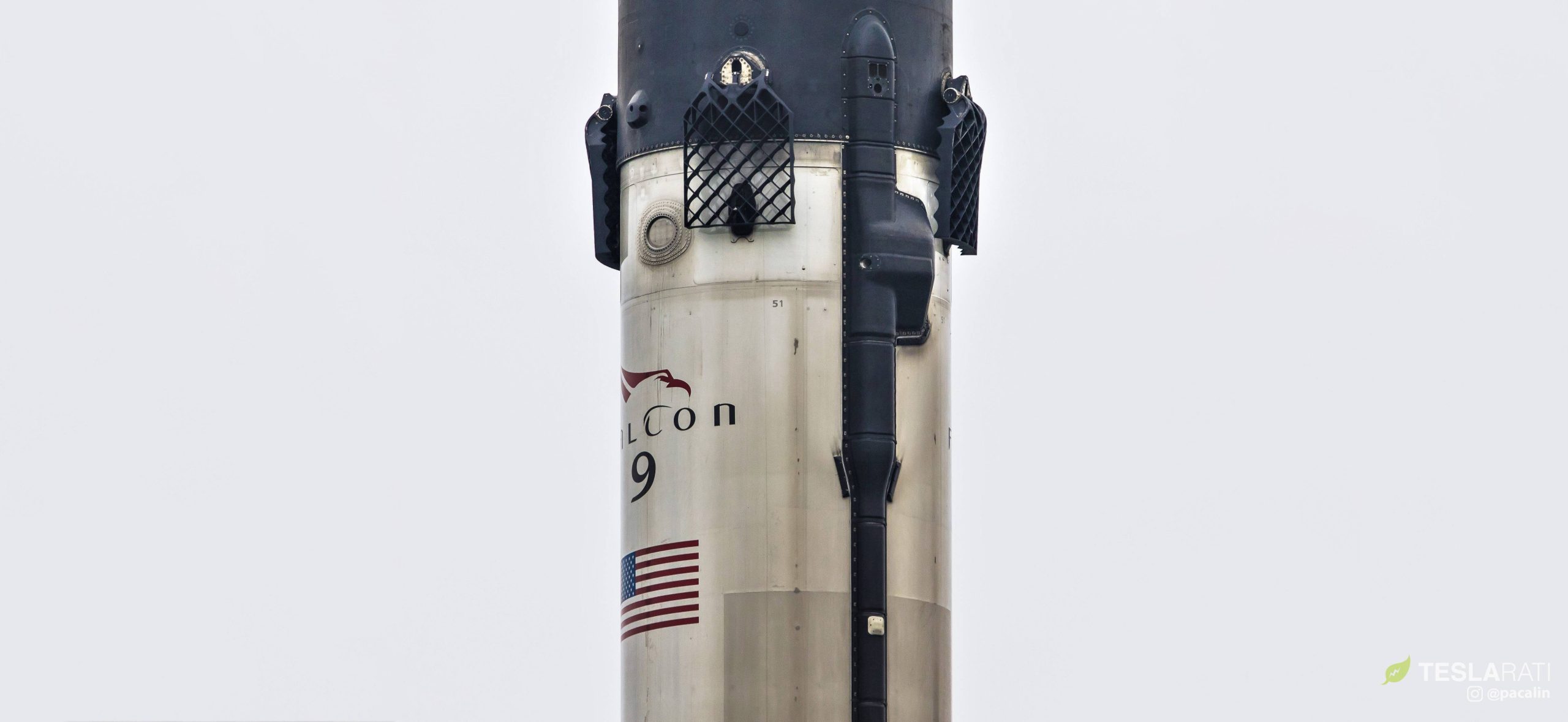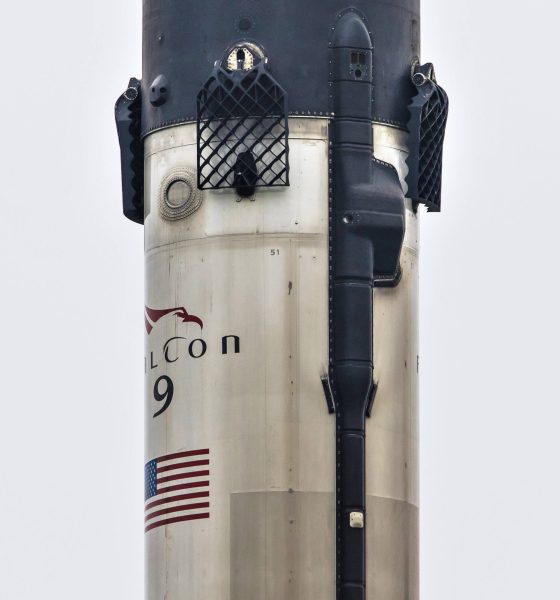

News
SpaceX Falcon 9 and $1B satellite trio set for first California launch in months
After the better part of both half a year of launch delays and launch pad inactivity, SpaceX and Falcon 9 are ready to return the company’s California-based SLC-4 facilities to action with the launch of the $1 billion Radarsat Constellation Mission (RCM).
Built by Maxar for the Canadian Space Agency (CSA), RCM is a trio of remote-sensing spacecraft designed with large surface-scanning radars as their primary payload. Having suffered years of technical delays during Maxar’s production process, RCM was initially available for launch as early as November 2018. In an unlucky turn of events, issues on the SpaceX side of things took RCM’s assigned Falcon 9 booster out of commission and lead to an additional seven or so months of launch delays. At long last, RCM is just one week away from heading to orbit, scheduled to launch from Vandenberg Air Force Base (VAFB) no earlier than 7:17 am PDT (14:17 UTC), June 12th.
The Goldilocks booster
Once the three RCM satellites were effectively complete, a series of unfortunate circumstances combined to delay the constellation’s launch almost indefinitely. The first domino fell in December 2018, when Falcon 9 Block 5 booster B1050 – having successfully supported Cargo Dragon’s CRS-16 launch – suffered a failure that prevented a successful landing. Incredibly, the booster did survive its accidental Atlantic Ocean landing and is now sitting in a SpaceX hangar, but B1050 is unlikely to ever fly again.
This posed a problem for Maxar and the Canadian Space Agency (CSA), who seem to have contractually requested that RCM launch on either a new or very gently flight-proven Falcon 9 booster. The problem: SpaceX had none of either option available for RCM after B1050’s unplanned swim and needed to balance the needs of several other important customers. Several Block 5 boosters were technically available but all had two or even three previous launches under their belts.

Meanwhile, SpaceX’s booster production had been almost entirely focused (and would remain so months after) on building four new Falcon Heavy boosters and the first expendable Falcon 9 Block 5 booster, reserved for the US Air Force and a long-delayed customer. Since those five boosters were completed and shipped out, just one additional booster (B1056) has been finished, launching Cargo Dragon’s CRS-17 mission just one month ago.
In short, had Maxar/CSA waited for a new booster, RCM’s launch would likely be delayed at least another 30-60 days beyond its current target of June 11th. Instead, they downselected to Falcon 9 B1051, then in the midst of several months of prelaunch preparations for Crew Dragon’s launch debut (DM-1). DM-1 went off without a hitch in early March, after which the gently-used B1051 underwent a brisk ~45 days of inspection and refurbishment before heading west to SpaceX’s VAFB launch pad.

Billion Dollar Babies
From an external perspective, forgoing a twice or thrice-flown Falcon 9 Block 5 booster after nearly a dozen successful demonstrations does not exactly appear to be a rational decision. However, whether it was motivated by conservatism, risk-aversion, or something else, Maxar and CSA likely have every contractual right to demand certain conditions, as long as they accept the consequences of those requirements. In the case of RCM, the customers accepted what they likely knew would be months of guaranteed delays to minimize something they perceived as a risk.
To some extent, it’s hard to blame them. After going more than $400M over budget, the Maxar-built trio of upgraded Radarsat satellites are expected to end up costing more than $1 billion. CSA’s annual budget typically stands around $250M, meaning that this single launch is equivalent to four years of space agency’s entire budget. A failed launch would be a huge setback. Additionally, RCM will likely become the most valuable payload ever launched by SpaceX, beating out the Air Force’s ~$600M GPS III SV01 spacecraft by a huge margin. For RCM, mission assurance is definitively second to none.


If all goes as planned, Falcon 9’s RCM launch should also mark the second use of SpaceX’s West Coast landing zone (LZ-4), christened during the October 2018 launch of SAOCOM 1A – coincidentally, also a radar-carrying Earth observation satellite. This means that press photographers (including Teslarati’s Pauline Acalin and Tom Cross) will have their second chance ever to capture remote images of a SpaceX booster landing.
Check out Teslarati’s Marketplace! We offer Tesla accessories, including for the Tesla Cybertruck and Tesla Model 3.

News
Tesla China delivery centers look packed as 2025 comes to a close
Needless to say, it appears that Tesla China seems intent on ending 2025 on a strong note.

Tesla’s delivery centers in China seem to be absolutely packed as the final days of 2025 wind down, with photos on social media showing delivery locations being filled wall-to-wall with vehicles waiting for their new owners.
Needless to say, it appears that Tesla China seems intent on ending 2025 on a strong note.
Full delivery center hints at year-end demand surge
A recent image from a Chinese delivery center posted by industry watcher @Tslachan on X revealed rows upon rows of freshly prepared Model Y and Model 3 units, some of which were adorned with red bows and teddy bears. Some customers also seem to be looking over their vehicles with Tesla delivery staff.
The images hint at a strong year-end push to clear inventory and deliver as many vehicles as possible. Interestingly enough, several Model Y L vehicles could be seen in the photos, hinting at the demand for the extended wheelbase-six seat variant of the best-selling all-electric crossover.
Strong demand in China
Consumer demand for the Model Y and Model 3 in China seems to be quite notable. This could be inferred from the estimated delivery dates for the Model 3 and Model Y, which have been extended to February 2026 for several variants. Apart from this, the Model Y and Model 3 also continue to rank well in China’s premium EV segment.
From January to November alone, the Model Y took China’s number one spot in the RMB 200,000-RMB 300,000 segment for electric vehicles, selling 359,463 units. The Model 3 sedan took third place, selling 172,392. This is quite impressive considering that both the Model Y and Model 3 are still priced at a premium compared to some of their rivals, such as the Xiaomi SU7 and YU7.
With delivery centers in December being quite busy, it does seem like Tesla China will end the year on a strong note once more.
News
Tesla Giga Berlin draws “red line” over IG Metall union’s 35-hour week demands
Factory manager André Thierig has drawn a “red line” against reducing Giga Berlin’s workweek to 35 hours, while highlighting that Tesla has actually increased its workers’ salaries more substantially than other carmakers in the country.

Tesla Giga Berlin has found itself in a new labor dispute in Germany, where union IG Metall is pushing for adoption of a collective agreement to boost wages and implement changes, such as a 35-hour workweek.
In a comment, Giga Berlin manager André Thierig drew a “red line” against reducing Giga Berlin’s workweek to 35 hours, while highlighting that Tesla has actually increased its workers’ salaries more substantially than other carmakers in the country.
Tesla factory manager’s “red line”
Tesla Germany is expected to hold a works council election in 2026, which André Thierig considers very important. As per the Giga Berlin plant manager, Giga Berlin’s plant expansion plans might be put on hold if the election favors the union. He also spoke against some of the changes that IG Metall is seeking to implement in the factory, like a 35-hour week, as noted in an rbb24 report.
“The discussion about a 35-hour week is a red line for me. We will not cross it,” Theirig said.
“(The election) will determine whether we can continue our successful path in the future in an independent, flexible, and unbureaucratic manner. Personally, I cannot imagine that the decision-makers in the USA will continue to push ahead with the factory expansion if the election results favor IG Metall.”
Giga Berlin’s wage increase
IG Metall district manager Jan Otto told the German news agency DPA that without a collective agreement, Tesla’s wages remain significantly below levels at other German car factories. He noted the company excuses this by referencing its lowest pay grade, but added: “The two lowest pay grades are not even used in car factories.”
In response, Tesla noted that it has raised the wages of Gigafactory Berlin’s workers more than their German competitors. Thierig noted that with a collective agreement, Giga Berlin’s workers would have seen a 2% wage increase this year. But thanks to Tesla not being unionized, Gigafactory Berlin workers were able to receive a 4% increase, as noted in a CarUp report.
“There was a wage increase of 2% this year in the current collective agreement. Because we are in a different economic situation than the industry as a whole, we were able to double the wages – by 4%. Since production started, this corresponds to a wage increase of more than 25% in less than four years,” Thierig stated.
News
Tesla is seeing a lot of momentum from young Koreans in their 20s-30s: report
From January to November, young buyers purchased over 21,000 Teslas, putting it far ahead of fellow imported rivals like BMW and Mercedes-Benz.

Tesla has captured the hearts of South Korea’s 20s-30s demographic, emerging as the group’s top-selling imported car brand in 2025. From January to November, young buyers purchased over 21,000 Teslas, putting it far ahead of fellow imported rivals like BMW and Mercedes-Benz.
Industry experts cited by The Economist attributed this “Tesla frenzy” to fandom culture, where buyers prioritize the brand over traditional car attributes, similar to snapping up the latest iPhone.
Model Y dominates among young buyers
Data from the Korea Imported Automobile Association showed that Tesla sold 21,757 vehicles to the 20s-30s demographic through November, compared to BMW’s 13,666 and Mercedes-Benz’s 6,983. The Model Y led the list overwhelmingly, with variants like the standard and Long Range models topping purchases for both young men and women.
Young men bought around 16,000 Teslas, mostly Model Y (over 15,000 units), followed by Model 3. Young women followed a similar pattern, favoring Model Y (3,888 units) and Model 3 (1,083 units). The Cybertruck saw minimal sales in this group.
The Model Y’s appeal lies in its family-friendly SUV design, 400-500 km range, quick acceleration, and spacious cargo, which is ideal for commuting and leisure. The Model 3, on the other hand, serves as an accessible entry point with lower pricing, which is valuable considering the country’s EV subsidies.
The Tesla boom
Experts described Tesla’s popularity as “fandom culture,” where young buyers embrace the brand despite criticisms from skeptics. Professor Lee Ho-geun called Tesla a “typical early adopter brand,” comparing purchases to iPhones.
Professor Kim Pil-soo noted that young people view Tesla more as a gadget than a car, and they are likely drawn by marketing, subsidies, and perceived value. They also tend to overlook news of numerous recalls, which are mostly over-the-air software updates, and controversies tied to the company.
Tesla’s position as Korea’s top import for 2025 seems secured. As noted by the publication, Tesla’s December sales figures have not been reported yet, but market analysts have suggested that Tesla has all but secured the top spot among the country’s imported cars this year.








